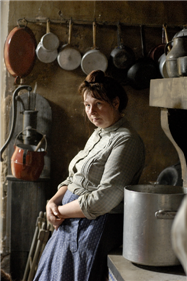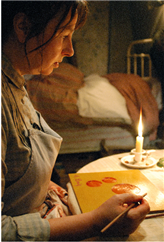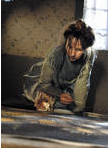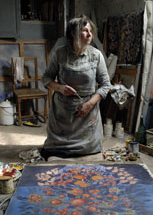4-19-09
Visions and Voices: On the Muses of Seraphine
By Diane Sippl

One of Eric Rohmer’s earliest
films, La Collectionneuse, is in
essence about three “collectors” idling away the summer in the south of France,
namely, an off-handedly attractive young woman who appears to take on a new
sexual conquest nightly and a pair of male guests who have been invited to stay
at the same 17th-century villa where she visits. One of them is an art dealer and the other, a
painter, but both, we could say, are collectors of ideas and philosophies. Strangely, all three characters come to mind, along with
their sensual outings in the divinely pristine landscape never violated by
Rohmer’s naturalistic lens, as we follow the emerging relationship between Séraphine
Louis (Yolande Moreau) and Wilhelm Uhde (Ulrich Tukor) in this season’s
award-winning eye-opener, Séraphine, a
highlight of the 13th “City of Lights, City of Angels” week of French film premieres in Hollywood, April 20th-26th at the Directors
Guild of America.
In Séraphine, writer-director Martin Provost has created a
fictionalized account of the eponymous artist’s life between 1912 and 1942,
positing Wilhelm Uhde as Séraphine’s muse if she would ever have laid claim to one
beyond God above and his Blessed Virgin.
The film shows that it was primarily her awe of nature that compelled
her to paint, but that it was primarily Uhde who nurtured her and most
certainly attracted her as an admirer every bit as much as he admired her work,
wild paintings of fruits and flowers and trees that seemed to possess a life of
their own. In a telling scene well into
the film, avant-garde art dealer Uhde coins the phrase “modern primitives” as
he is being interviewed at his comfortable home in Chantilly as to why he
returned to

Here it’s useful to back up. Séraphine de Senlis, as she came to be known (after the town where she lived) was a shepherdess as a child and then, as a teenager, worked as a maid in an institute for young women where she was able to observe the drawing teacher’s classes. At age eighteen she became a servant for the nuns at Saint-Joseph-de-Cluny Convent where she worked for the next two decades. When in the early years of the 20th century she left and was working again as a maid at middle age, one of her guardian angels pointed her down the path of painting, according to Séraphine, who never ceased to respond to these visions and voices that guided her. By 1912 she was doing an hour of housework each morning for a petit bourgeois family in Senlis. This allowed her to dwell in her own meager attic room and, more significantly, to venture into the woods nearby. There she collected soil and plants that she used (along with paraffin from vigil candles she pilfered from the cathedral and blood from animal organs simmering on the château stove) to mix her own pigments with a mortar and pestle. She applied them to wood with her fingertips. The result was something magical.
It’s important to note that in the film her modest life as an artist is as meted out as her humble routine as a cleaner. Church bells and the chimes of clocks mark the hours in this quiet gothic town, the grays of the walls and cobblestones accentuated only by the blues of Séraphine’s dress and shawl, of the clouds and the river, and the greens of the foliage that engulfs her on her daily walks. These walks commence at dawn or earlier, Séraphine with her basket or wheelbarrow, off through the meadows or marshes. Most everything begins and ends in the dark for her, except the paint she applies, crouched on the floor in the quiet of candle light in the middle of the night, unless she breaks into song, generally a hymn or a chant. And then the film fades to black and a new day commences.

All of this changes only somewhat
when she meets Wilhelm Uhde and is assigned to clean the rooms he rents at
the château of her employer in Senlis.
Séraphine finds a Picasso drawing of a lover’s embrace as she makes up
Uhde’s bed. She admires his handwriting
in his daily journal of life in the countryside, illustrated, no less. Stealing a look at his passages, she devours them word by word,
as she does his note on the breakfast table, “Gone to
In the contrasting rich brown
interiors of lamp-lit wood walls, the neighbors gather to honor and ogle Uhde,
to wine and dine his fine taste as he coyly shrinks back from their ridicule of
“lunatics who paint like six-year-olds.”
Seduced by a discarded miniature of Séraphine’s apples painted on wood, he
buys it from the hostess and bolts back to his room sans meringue flambé to enter
a fascinating exchange of looks — between his eyes and the apples — lit by a
single flame. A
series of close-ups (a
struck match, igniting a candle, lighting up the painting, reflected on
his face) kindles the bond between subject and subject: painting and
spectator, maker
and consumer, artist and dealer, Séraphine and Uhde. “Do you have any others? You must give them to me immediately,” he
gasps at her door. Of course he means
paintings, and she retrieves them and he pays her. Yet it’s not easy to say whether the
overwhelmed look on her face, once she’s alone, is for the coins she dropped in
her box, the admiration of her art, or the flutter in her heart.

Set aside Wilhelm Uhde’s lover, Helmut Kolle, who while he visits Uhde paints a portrait of Anne-Marie, Uhde’s sister, these two relations yet uncovered by Séraphine. It’s a suspenseful romance waiting to happen, in her eyes, and waiting to come crashing down, in ours. And we look for the obscured details foreshadowing its consequences, cinema being all about people looking at people looking. And, once again, the screen fades to black.
More rewarding are the counterpoint scenes, the rightful centerpieces of the film, with Séraphine painting in her prime. After all, Uhde has told her, “You can’t keep cleaning when you have gold in your hands.” But Séraphine mutters an adage from S. Teresa de Avila, “Be ardent in your work and you will find gold in your cooking pots.” Uhde sits her down on a heart-shaped chair and, stooping low like a lover to propose, promises to look after her. He hands her money and offers her more, which she refuses. And then he’s out the door to his homeland in 1914.

Séraphine offers intimate portraits of this artist at work
throughout the war, more prodigious than ever, her panels taking up the floor
of her dwelling as she puts more paint on the wood than food in her
stomach. When a local newspaper touts
the success of her work on exhibit at the
What transpires at this point can be ascribed to any of many symptoms and causes: extreme religious mysticism, psychological delirium and delusions of grandeur, longstanding physical deprivation, anxiety over performance expectations and shattered dreams, abrupt economic disorientation, global crisis, and loss of faith and trust in a beloved. The film shows Uhde making Séraphine’s confined life thereafter as comfortable as possible.
Outside the film, we know that
the day she was committed to Clermont-de-l’Oise psychiatric hospital, she
refused to paint ever again. Yet in that
same year, 1932, her works were shown in the

Having based his film on the
thesis about Séraphine by psychiatrist Françoise Cloarec and the collection she
owns of the letters of her acquaintance, Anne-Marie Uhde, who in truth
discovered the artist, Martin Provost organized several retrospectives of
Séraphine’s work in conjunction with making his film. Bertrand Lorquin, curator of the Musée
Maillol, referred to her “modern primitivism” as “the power of representing the
world of the unconscious liberated from any school, from any form of
academicism, and from any connection….
Divided between the art of pathology and the dazzling of her spirit,
Séraphine is inhabited by visions she sometimes discovers by looking at the
illuminated rosette of the Senlis cathedral.”
Among all the questions raised by the film — about sources of
inspiration, the workings of the imagination, the means of creativity, the
relation between the artist and the métier and money, the possibility of
steadfast integrity, the resiliency of the spirit — at least some of these give
rise to other questions, about what kind of film can address the work of such
an artist, and how that film can be made.
Dreyer, Bresson, and Vadim have all sought to present (if not to represent)
Joan of Arc and her visions. Yet as for
portraying artists, how to focus and to generate a dialogue among layers of
meaning via the screen is a presiding question.
Provost often places the artist, the method, the process, the result,
and the reaction before our eyes all at once — in a single sequence and
sometimes within a single frame, inviting a host of interpretations, visceral
and theoretical alike. They give us pause to reflect on how we make meaning in
our lives. Ironically, Provost’s simple
static shots of Séraphine’s destitute circumstances but disciplined daily
rituals betray a hidden world of immense autonomy and abundance. Séraphine won seven French Césars,
including Best Film, Best Actress, Best Original Screenplay, Best Music, Best
Cinematography, Best Set Design, and Best Costumes. In and of itself, it is an inspired and finely crafted work of art.
Séraphine
Director: Martin Provost; Producers: Miléna Poylo and Gilles Sacuto; Screenplay: Martin Provost and Marc Abdelnour; Cinematography: Laurent Brunet (AFC); Sound: Philippe Van den Driessche; Editor: Ludo Troch; Original Score: Michael Galasso; Set Design: Thierry François; Costumes: Madeline Fontaine.
Cast: Yolande Moreau, Ulrich Tukor, Anne Bennent, Geneviève Mnich, Nico Rogner, Adélaïde Leroux, Serge Larivière, Françoise Lebrun.
Color, 35mm, 125 minutes. In French and German with English subtitles.